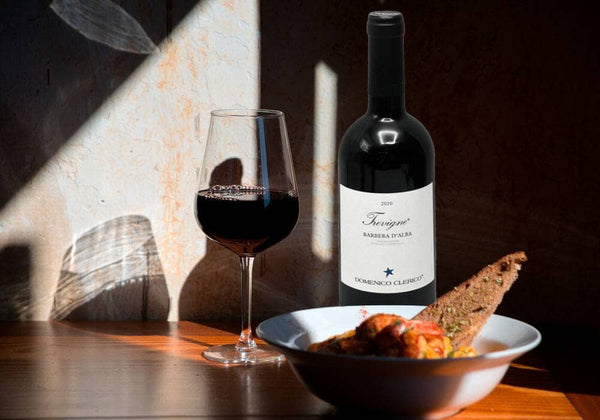What’s So Special about Barbera Wine?

It’s time to discuss one of the greats of Italian wine and the grape it’s made from.
Where Does Barbera Come From?
Barbera is a red grape variety from Italy, which in 2000 was the third most planted variety in this country after Sangiovese and Montepulciano. Almost half of the vineyards in Piedmont are planted with this variety. It is not found in the rest of Europe, except for a small amount in Greece and Romania. It produces good yields and is known for its deep color, low tannins, and high acidity. Recent DNA analysis suggests that the Barbera could be related to the Franco-Spanish Mourvedre vine.
Centuries-old vines of this variety still exist in many Italian regions and allow the production of long-aged, robust red wines with intense fruit, which you can taste when you buy red wine online. These Old Vine wines have a higher tannin content. Barbera is believed to have originated in the Monferrato hills in central Piedmont, Italy, where it became known in the 13th century.
The main areas where the Barbera grape is found are: the Piedmont denominations of origin: DOC Barbera d'Alba, DOC Barbera d'Asti, DOC Barbera del Monferrato, DOC Piamonte Barbera, DOC Colli Tortonesi, DOC Canavesi Barbera, DOC Colline Novaresi Barbera, DOC Gabiano, DOC Rubino di Cantavenna. Outside Piedmont in the DOC Oltrepò Pavese Barbera in Lombardy, DOC Colli Bolognesi in Emilia Romagna, DOC Castel San Lorenzo Barbera in Campania.
Outside of Europe it is found in Australia where it adapted very well to the soil. Barbera is also cultivated in California and in South America (Argentina, Brazil and Uruguay) where it followed the Italian immigrants. Argentina produces fine Barbera wines, mainly in Mendoza and San Juan, although it is also excellent in Salta, despite the small amount cultivated.
What do Barbera Wines Taste Like?
In the past, Barbera wines were always considered peasant wines. Twenty-five years ago, for example, Barbera was used for table wines, not for finer wines, especially sparkling and frizzanti wines due to their high acidity. The yields were very high, which highlighted its tremendous acidity even further. However, these days, it is a key grape in the vinification of good quality wines that are often exported.
Regarding its characteristics, unlike Nebbiolo, the skins of Barbera grapes release their anthocyanins only after a few days of fermentation. It is highly resistant to fungi and is capable of producing good harvests on different types of soil. The vine is very vigorous and capable of producing high yields if not kept under control by the vineyard manager.
Among the different Barbera wines in Italy, the ones from Alba are more structured, powerful, and fleshy. The Italian red wine from Asti is softer and rounder, fine and elegant with good structure. The wine from Monferrato is fresher, lighter, and easier to drink.
The organoleptic characteristics that we can find in a high-quality Berbera wine are:
Color: Ruby red with good intensity. Every day there more wines are being made with a great color intensity.
Aromas: primarily floral, such as rose petals and violets. Also, herb-like aromas such as sage. And fruit notes like cherries, plums, currants, raspberries. It can be a bit spicy, including hints of pepper, cloves, and cinnamon.
On the palate: Good texture, balance, with marked but not annoying acidity and a medium body, pleasant, featuring a medium to long finish, all of which invites you to drink more.
Four Barbera Wines from Bottle Barn to Try Now
So, the next time you buy red wine online, try some Italian wine, Barbera in particular!
- The 2018 Oddero Nizza Barbera d'Asti is made from certified organic grapes from the Nizza sub-region of the Barbera D’Asti DOCG. It’s had separate DOCG status since 2014. Compared to Alba vineyards, Asti’s soil has more sand, with steeper hills and a warmer climate. “Boasting notes of roses, ripe cherries, bitter chocolate and coffee, this drinks well with rich pasta and meat dishes,” says the winemaker.
- Speaking of Alba, there’s the 2020 Domenico Clerico Trevigne Barbera d'Alba. TreVigne means this wine comes from grapes harvested on three distinct plots of land with unique characteristics. The winemaker then creates “an orchestra that plays on the notes of the red fruit, seeking the balance between the softness and vibrant acidity typical of this variety.”
- The Trecini Barbera d'Asti Superiore of the 2015 vintage bears the Superiore classification, which means it must have at least 12.5% alcohol by volume and be aged for at least 14 months before release, with six of those months in oak or chestnut barrels. The maturation in small oak barrels produces rounder taste in this incredible value Italian wine.
- Another wine with the Superiore designation is the 2018 Gianfranco Bovio Regiaveja Barbera d'Alba Superiore. In awarding this wine 91 points, Vinous said it’s “packed with blue/purplish fruit, spice, new leather and licorice.” This wine comes from a boutique estate winery on 6.5 hectares of vineyards. over 6.5 hectares. Alessandra and her husband Marco Boschiazzo continue a family tradition. Their winemaking philosophy is embedded in tradition and terroir, including ageing the wines in large oak casks.
We hope you learned something about Barbera wine in this blog! Be sure to review the dozens of articles on wine found on the Bottle Barn website!


















Leave a comment